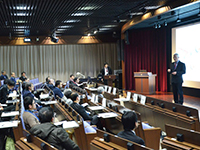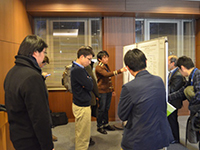ERATO, Strategic Basic Research Programs http://www.jst.go.jp/erato/
ERATO International Workshop: Challenges in Precision Science was held at Koshiba Hall, the University of Tokyo from January 25 to 27 at the time of completing Katori innovative space-time project.
The “optical lattice clock” was the theme of the project. It is an atomic clock invented by Hidetoshi Katori (Professor, the University of Tokyo), the Director of the project in 2001. In 2006, International Committee for Weights and Measures (CIPM) adopted the optical lattice clock as “the secondary representation of the second” which implies a potential candidate for the future “redefinition of the second”. In recent years, many research institutes around the world are working on developing the optical lattice clocks.
In this symposium, 19 outstanding researchers active in the front line field of “precision measurements” both from inside and outside of Japan got together. They are:
-Dr. Fritz Riehle (PTB) who is one of the leading researchers associated with the field of “redefinition of seconds”
-Dr. Jun Ye (JILA) and Dr. Sébastien Bize (LNE-SYRTE) who are counterparts of the development of optical lattice clocks in the US and Europe
-Dr. Thomas Udem (Max Planck) researching on optical frequency comb and precision spectroscopy, which is one of the important elements to develop optical clocks and exploring theoretical physics.
-Dr. Marianna Safronova (Univ. of Delaware) who is planning to use precise atomic clocks in the fundamental physics field
-Dr. Guglielmo Tino (Univ. of Firenze) who is leading the measurement of gravitational constant with an atomic interferometer.
Achievement of ERATO project and relevant latest results were presented by them and their prospects for the future were shared with the participants.
On the first and the second day, 24 poster were presented and in the afternoon of the last day, a laboratory tour to Katori Laboratory in RIKEN was conducted. In the tour menu, optical lattice clocks of various atomic species constructed in Riken, optical cavities, the optical frequency comb and some other experimental apparatus were shown to the visitors .
Also, eminent persons related to concerned authorities made remarks in this symposium. At the beginning, Makoto Gonokami, President of the University of Tokyo and Hiroshi Ikukawa, Director-General of Research Promotion Bureau in MEXT gave opening remarks, followed by Prof. Katsumi Midorikawa, director of Center for Advanced Photonics, RIKEN, and Mitsuyuki Ueda, director of the Office for Quantum and Radiation Research who presented their views on second and last day of the symposium respectively. They expressed their expectations on various innovative research work presented such as optical lattice clocks that can cause a big impact on our lives in the future.
In all, 127 participants including members from 8 foreign countries attended this symposium. The lively discussions made the conference a success.
- - Overview of the event
- http://www.amo.t.u-tokyo.ac.jp/iwcps2016/index.html

Venue

Poster presentations
JST, an integrated organization of science and technology in Japan, establishes an infrastructure for the entire process from the creation of knowledge to the return to the society. For more information, visit http://www.jst.go.jp/EN/